A fighting game is a genre of video game that involves combat between two or more characters. Fighting game combat often features mechanics such as blocking, grappling, counter-attacking, and chaining attacks together into "combos". Characters generally engage in battle using hand-to-hand combat—often some form of martial arts. The fighting game genre is related to, but distinct from, the beat 'em up genre, which pits large numbers of computer-controlled enemies against one or more player characters.
A sports video game is a video game that simulates the practice of sports. Most sports have been recreated with a video games, including team sports, track and field, extreme sports, and combat sports. Some games emphasize actually playing the sport, whilst others emphasize strategy and sport management. Some, such as Need for Speed, Arch Rivals and Punch-Out!!, satirize the sport for comic effect. This genre has been popular throughout the history of video games and is competitive, just like real-world sports. A number of game series feature the names and characteristics of real teams and players, and are updated annually to reflect real-world changes. The sports genre is one of the oldest genres in gaming history.
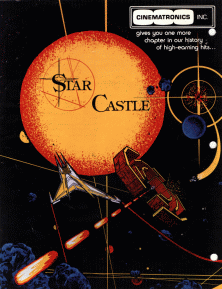
Star Castle is a vector graphics multidirectional shooter released in arcades by Cinematronics in 1980. The game involves obliterating a series of defenses orbiting a stationary turret in the center of the screen. The display is black and white with the colors of the rings and screen provided by a transparent plastic screen overlay.

Ikari Warriors, known as Ikari in Japan, is a vertically scrolling run and gun video game released for arcades by SNK in 1986. It was published in North America by Tradewest. At the time there were many Commando clones on the market. What distinguished Ikari Warriors were rotary joysticks and a two-player cooperative mode. The rotary joystick controls were in turn based on SNK's earlier TNK III (1985). Ikari was originally intended to be an official licensed adaptation of the film Rambo: First Blood Part II (1985), but SNK were initially unable to acquire the rights to the film.
The golden age of arcade video games was the period of rapid growth, technological development, and cultural influence of arcade video games from the late 1970s to the early 1980s. The release of Space Invaders in 1978 led to a wave of shoot-'em-up games such as Galaxian and the vector graphics-based Asteroids in 1979, made possible by new computing technology that had greater power and lower costs. Arcade video games switched from black-and-white to color, with titles such as Frogger and Centipede taking advantage of the visual opportunities of bright palettes.

Cinematronics Incorporated was an arcade game developer that primarily released vector graphics games in the late 1970s and early 1980s. While other companies released games based on raster displays, early in their history, Cinematronics and Atari, Inc. released vector-display games, which offered a distinctive look and a greater graphic capability, at the cost of being only black and white (initially). Cinematronics also published Dragon's Lair in 1983, the first major LaserDisc video game.
The following article is a broad timeline of arcade video games.
1979 saw many sequels and prequels in video games, such as Space Invaders Part II and Super Speed Race, along with new titles such as Asteroids, Football, Galaxian, Head On, Heiankyo Alien, Monaco GP, Sheriff and Warrior. For the second year in a row, the highest-grossing video game was Taito's arcade game Space Invaders and the best-selling home system was the Atari Video Computer System.
1976 had new titles such as Road Race, Night Driver, Heavyweight Champ, Sea Wolf and Breakout. The year's highest-grossing arcade games were Namco's F-1 in Japan and Midway's Sea Wolf in the United States.
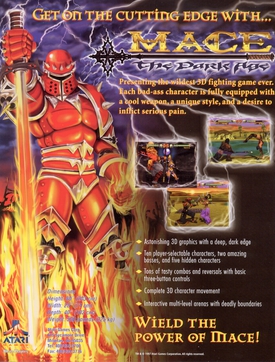
Mace: The Dark Age is a fighting video game released by Atari Games for arcade machines in 1997 and later ported by Midway Games to the Nintendo 64. Like many fighting games of the time, its style is marked by extreme violence, with characters graphically slaying defeated opponents. Utilizing 3dfx Voodoo chips for the hardware, the game received attention for its cutting-edge graphics and turned Atari a profit in the arcades. Critical response to the gameplay was much less enthusiastic.
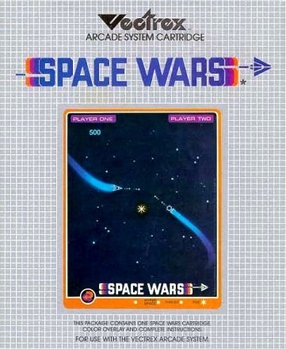
Space Wars is a shooter video game released in arcades by Cinematronics in 1977. It is based on the PDP-1 game Spacewar! (1962) but instead uses vector graphics for the visuals. The hardware developed for Space Wars became the platform for most of the vector-based arcade games from Cinematronics. It was distributed in Japan by Taito in 1978, and a Vectrex port was published in 1982.
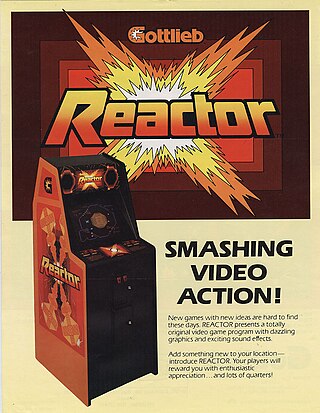
Reactor is an arcade video game released in 1982 by Gottlieb. The object of the game is to cool down the core of a nuclear reactor without being pushed into its walls by swarms of subatomic particles. Reactor was developed by Tim Skelly, who previously designed and programmed a series of vector graphics arcade games for Cinematronics, including Rip Off. It was the first arcade game to credit the developer on the title screen. Reactor was ported to the Atari 2600 by Charlie Heath and published by Parker Brothers the same year as the original.
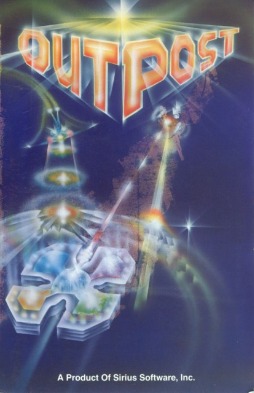
Outpost is a fixed shooter for the Apple II programmed by Tom McWilliams and published by Sirius Software in 1981. It is a variant of the arcade game Space Zap.
Tim Skelly was a video game designer and game programmer who developed arcade games for Cinematronics from 1978 until 1981. He designed a series of pure action games using black and white vector graphics. One of his early games, Rip Off, was the first arcade game with two-player cooperative play. Star Hawk, Rip Off, Armor Attack, and Star Castle were all later ported to the Vectrex home system.
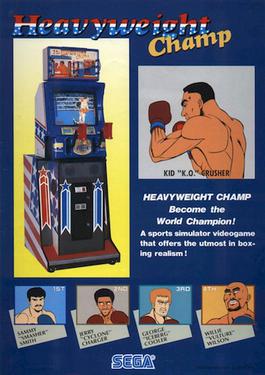
Heavyweight Champ is a series of boxing video games from Sega. The original arcade video game was released in 1976. The game uses black-and-white graphics and critics have since identified it as the first video game to feature hand-to-hand fighting. It was a commercial success in Japan, where it was the third highest-grossing arcade video game of 1976.
Vectorbeam was an arcade game manufacturer active in the late 1970s who specialized in vector graphics-based arcade games. It was formed after splitting off from its primary competitor, Cinematronics, and disappeared after re-merging with them soon after.
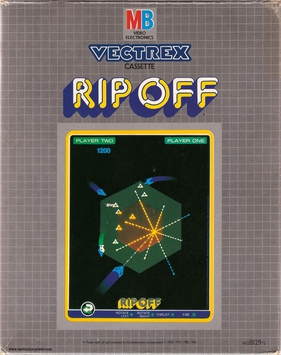
Rip Off is a multidirectional shooter with black and white vector graphics written by Tim Skelly and released as an arcade video game by Cinematronics in 1980. It was the first shooter with cooperative gameplay and an early game to exhibit flocking behavior. A port for the Vectrex was published in 1982.

Sundance is a puzzle arcade video game using vector graphics released by Cinematronics in 1979. The game consists of two grids floating in a pseudo-3D space with small suns bouncing between them.
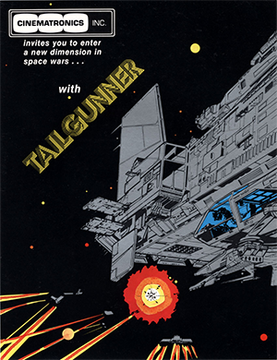
Tail Gunner is a monochrome vector arcade game created by Vectorbeam in 1979. The premise of the game is that the player is the tailgunner of a large space ship. Enemy spacecraft attack the vessel in groups of three, and the player must aim a set of crosshairs and shoot the enemies before they slip past the player's cannons. Because of the game's viewpoint, instead of appearing to fly into the starfield, the stars move toward the left and center of the screen.

Jack the Giantkiller is a 1982 arcade game developed and published by Cinematronics. It is based on the 19th-century English fairy tale "Jack and the Beanstalk". In Japan, the game was released as Treasure Hunt. There were no home console ports.












